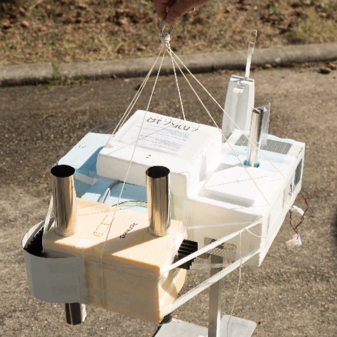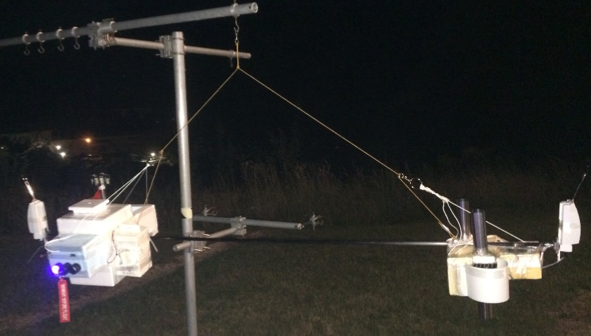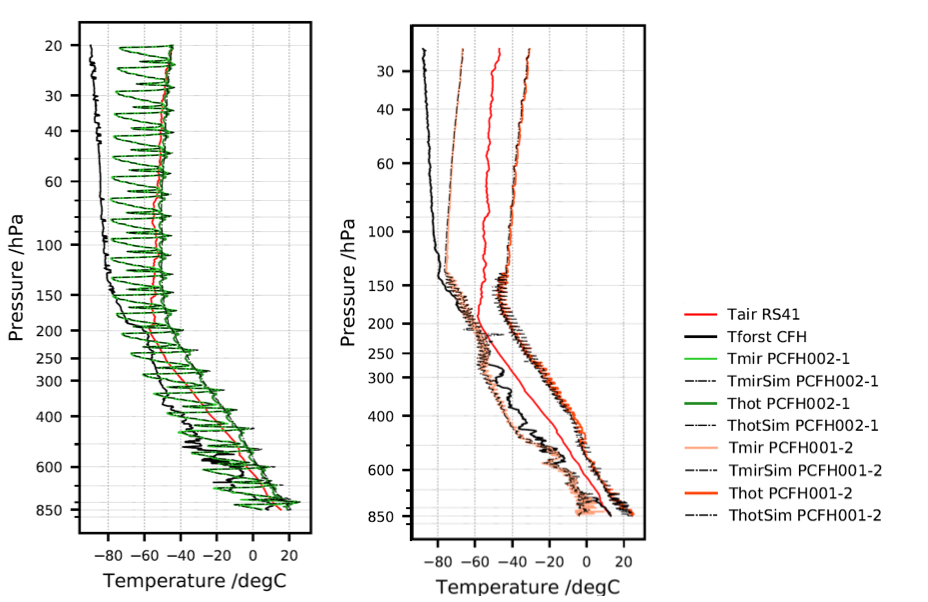Peltier Cooled Frost point Hygrometer (PCFH)
Instrument description

The PCFH (Peltier Cooled Frost point Hygrometer) instrument is a lightweight water vapor sonde designed to be flown in operational weather balloons. It is thought as a double instrument with two identical sensor units in individual flow tubes, supported by common electronics in a single polystyrene housing. The detection is based on the chilled mirror principle. A single stage Peltier element cools an aluminum gold plated mirror. The frost point temperature range reachable by the instrument is conditioned by the instrument ascent speed and air temperature. The hot side of the Peltier element is passively cooled by passing air through a heat sink. Light is reflected from the cold mirror and referenced to light reflected from a clean reference surface kept 3°C warmer than ambient air. The reflected light is kept constant and within an optimal interval by controlling the thickness of the ice layer formed in the cooled mirror by cooling or warming the mirror in relation to the unknown frost point temperature. Previous solutions have employed a proportional integral derivative (PID) control. With the full physical/mathematical description of the instrument implemented in a model, system modelling is possible and a more robust and sophisticated controller scheme is available. The instrument implementation with microcontroller and FPGA technology and extended telemetry packs allow for costumer tailored experiments in flight in each sub-unit of the instrument. Temperature is measured with copper-constantan thermocouples calibrated to Swiss national standards with an assembled precision of 0.01 K and accuracy of 0.1 K.

PCFH has been launched twice in July 2018 in Lindenberg Germany, together with colleagues from DWD (German Weather Service) and the GRUAN (GCOS reference upper air network) Lead Center. The PCFH was launched supported by the Vaisala radiosonde RS41. It is also supported by the radiosonde I-met (USA) with a plug-in in SkySonde. On a second flight it was launched together with other balloon borne instruments – COBALD and CFH (Cryogenic Frost Point Hygrometer).
PCFH Target Requirements
First Results
Below we show results from PCFH first and second flight. PCFH was flown in a system identification modus. The left panel, shows the ascent the second flight sub-unit 1. A cycle of known voltages is applied thought the entire flight. With this operation mode, we can identify the operation limits of the assembly, and characterize the instruments Peltier current and mirror and hot side temperature response to a known voltage in real atmospheric conditions. The right panel, shows the ascent the first flight sub-unit 2. A PID controller calibrated to ground conditions, alternates the reflectivity control point of the cold mirror reflectivity from 70% to 80% of clean mirror reflectivity. This results on the mirror temperature alternating around the frost point temperature until 500 hPa. After this point there was a disruption of the power supply and clean mirror reflectivity was changed. The black lines on top of the colorful lines are the simulated flight from the physical/mathematical model of the PCFH. They show an agreement with the real flight results within ± 2 °C. Design changes are underway to improve the operating range of PCFH. New tests are scheduled for December 2018.

